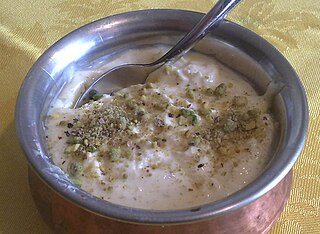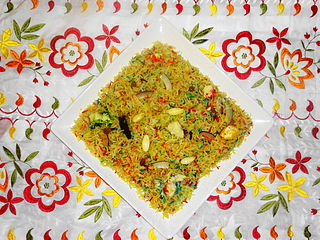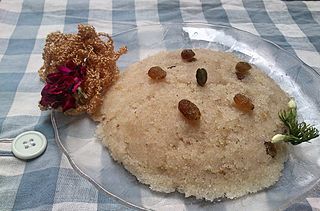
Indian cuisine consists of a variety of regional and traditional cuisines native to India. Given the diversity in soil, climate, culture, ethnic groups, and occupations, these cuisines vary substantially and use locally available spices, herbs, vegetables, and fruits.

Vermicelli is a traditional type of pasta round in section similar to spaghetti. In English-speaking regions it is usually thinner than spaghetti, while in Italy it is typically thicker.

Punjabi cuisine is a culinary style originating in the Punjab, a region in the northern part of South Asia, which is now divided in an Indian part to the east and a Pakistani part to the west. This cuisine has a rich tradition of many distinct and local ways of cooking. One is a special form of tandoori cooking that is now famous in other parts of Pakistan and India, England, Canada, America, and in many other parts of the world.

Gulab jamun is a sweet confectionery or dessert, originating in the Indian subcontinent and a type of mithai popular in India, Pakistan, Nepal, the Maldives, and Bangladesh, as well as Myanmar. It is also common in nations with substantial populations of people with South Asian heritage, such as Mauritius, Fiji, Gulf states, the Malay Peninsula, Great Britain, South Africa, and the Caribbean countries of Trinidad and Tobago, Guyana, Suriname, and Jamaica.

A falooda is a Mughlai cuisine version of a cold dessert made with noodles. It has origins in the Persian dish faloodeh, variants of which are found across West, Central, and South Asia. Traditionally it is made by mixing rose syrup, vermicelli, and sweet basil seeds with milk, often served with ice cream. The vermicelli used for preparing falooda is made from wheat, arrowroot, cornstarch, or sago.

Shrikhand is a traditional sweet of the Indian subcontinent made from strained yogurt. It is often served as part of a thali (platter) or with puris. It is a traditional dessert in Gujarati and Marathi cuisine.

Puri is a deep-fried bread made from unleavened whole-wheat flour that originated in the Indian subcontinent. It is eaten for breakfast or as a snack or light meal. It is usually served with a savory curry or bhaji, as in puri bhaji, but may also be eaten with sweet dishes.

Cuisine of the Indian subcontinent includes the cuisines from the Indian subcontinent comprising the traditional cuisines from Bangladesh, Bhutan, India, the Maldives, Nepal, Pakistan and Sri Lanka.
Mithai (sweets) are the confectionery and desserts of the Indian subcontinent. Thousands of dedicated shops in India, Bangladesh, Nepal, Pakistan and Sri Lanka sell nothing but sweets.

Gujarati cuisine is the cuisine of the Indian state of Gujarat. The typical Gujarati thali consists of rotli, dal or curry, rice, and shaak. The thali will also include preparations made from pulses or whole beans such as moong, black eyed beans etc., a snack item (farsaan) like dhokla, pathra, samosa, fafda, etc. and a sweet (mishthaan) like mohanthal, jalebi, doodh pak etc.

A buñuelo is a fried dough fritter found in Spain, Latin America, and other regions with a historical connection to Spaniards, including Southwest Europe, the Balkans, Anatolia, and other parts of Asia and North Africa. Buñuelos are traditionally prepared at Christmas. It will usually have a filling or a topping. In Mexican cuisine, it is often served with a syrup made with piloncillo.

Dhansak is a popular Indian dish, originating among the Parsi Zoroastrian community. It combines elements of Persian and Gujarati cuisine. Dhansak is made by cooking mutton or goat meat with a mixture of lentils and vegetables. This is served with caramelised white rice, which is rice cooked in water, whole spices, and caramelized onions. The dal cooked with mutton and vegetables served with brown rice, altogether is called dhansak.

Gunjiya, also known as Gughara, Pedakiya, Karanji, Kajjikayalu, Somas, and Karjikayi, is a sweet, deep-fried dumpling that is a popular dessert in the Indian subcontinent. This delicacy is made using either suji (semolina) or maida, which is stuffed with a mixture of sweetened khoa and dried fruits. The dumpling is then fried in ghee to give it a crispy texture.

Goan Catholic Cuisine is the cuisine of the Goan Catholic community and is largely influenced by the Saraswat, Konkani, Portuguese, South Indian, and British cuisines. Due to over 450 years of Portuguese rule, the cuisine of Goan Catholics is dominated by ingredients and techniques of Portuguese cuisine like deep-frying, oven-baking, pork, vinegar, egg-based desserts, alcohol, etc.

Zarda is a traditional boiled sweet rice dish, native to the Indian subcontinent, made with saffron, milk and sugar, and flavoured with cardamom, raisins, pistachios or almonds. The name 'zarda' comes from Persian word 'zard' زرد meaning 'yellow', because the food coloring added to the rice gives it a yellow color. Zarda is typically served after a meal. In the Indian subcontinent, zarda was and still remains a popular dessert on special occasions such as weddings. It is quite similar to sholezard, a traditional Iranian dessert, and zerde, a traditional Turkish dessert.

Carrot pudding is a dish traditional to a wide range of cultures around the world. It can be served either as a savoury pudding or as a sweet dessert.
Laapsi or lapsi is an Indian sweet dish which has a lot of variants and is made using grain flour or broken wheat and ghee, along with milk, nuts, raisins and other dried fruits. Lapsi is commonly prepared during Hindu ceremonies, and is served as a religious offering to Devtas. Lapsi forms an integral part of North Indian cuisine.

Pinni is a type of Punjabi and North Indian cuisine dish that is eaten mostly in winters. It is served as a dessert and is made from desi ghee, wheat flour, jaggery and almonds. Raisins may also be used. Urad dal pinni is a variety of pinni.

Suji ka Halwa is a type of halvah made by toasting semolina in a fat like ghee or oil, and adding a sweetener like sugar syrup or honey. It can be served for breakfast or as a dessert item. The basic recipe is made with just semolina, sugar or honey, ghee, and sometimes milk. Variations on this include dried or fresh fruits, nuts, shredded coconut, and other toppings.


















